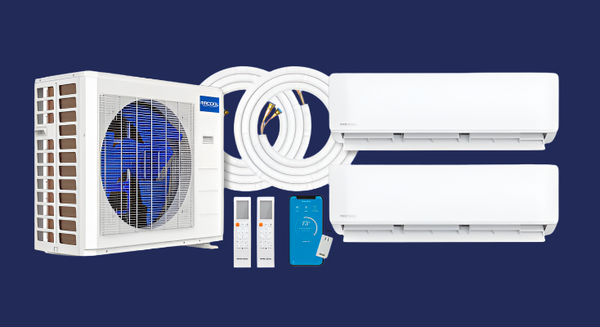Is MRCOOL HVAC Actually Any Good? An Honest Look at MRCOOL DIY Mini Splits
MRCOOL DIY mini splits get called everything from “junk” to “game-changer.” The truth is in the middle. This guide breaks down how MRCOOL stacks up against professionally installed HVAC, where these systems shine, where they fall short, and when a DIY mini split really makes sense in the lower 48 states.
Quick Takeaways
- MRCOOL DIY mini splits can be a solid value for garages, shops, bonus rooms, and add-ons.
- Most “MRCOOL problems” come from installation mistakes, not the brand itself.
- For large, complex whole-home, professional design may still be the smarter route to ensure balanced airflow and consistent comfort.
What Is MRCOOL HVAC and Why Does It Get So Much Attention?
MRCOOL is best known for its DIY mini split HVAC systems. These units are designed so many homeowners can install them without a traditional HVAC contractor needing to pull vacuum, braze line sets, or charge refrigerant. The pre-charged, quick-connect line sets are what make a MRCOOL DIY mini split different from most other brands.
That same DIY design is also why some professionals criticize MRCOOL. It challenges the traditional model where “you must hire a pro for everything,” and any time that happens, there’s going to be noise, debate, and strong opinions online.
Where MRCOOL DIY Systems Shine
No HVAC system is perfect, but MRCOOL HVAC units offer real advantages for the right homeowner.
1. Lower Upfront Cost vs. Many Professionally Installed Systems
When you factor in equipment, labor, and contractor markup, a traditional professionally installed mini split system can cost significantly more than a MRCOOL DIY mini split. With MRCOOL, you often save by handling the install yourself or with minimal help from an electrician or handy friend.
2. True DIY-Friendly Design
MRCOOL’s pre-charged line sets and DIY-oriented instructions mean MRCOOL DIY HVAC is intentionally packaged for non-HVAC professionals. You don’t need recovery machines, vacuum pumps, or refrigerant scales to get a basic system up and running when you follow the manual step by step.
3. Zoned Comfort and Energy Efficiency
A MRCOOL mini split lets you heat or cool specific rooms or zones instead of conditioning the whole house with a single thermostat. That can mean lower energy bills and better comfort in spaces like garages, bonus rooms, shops, and outbuildings.
4. Ideal for Garages, Shops, and Add-On Spaces
Many homeowners choose MRCOOL for areas a traditional ducted system doesn’t handle well: detached garages, workshops, basements, bonus rooms, and additions. In those cases, a MRCOOL DIY mini split is often simpler and more cost-effective than trying to extend existing ductwork.
Why Some People Say MRCOOL Is “Junk”
On the other side, you’ll see videos and posts from technicians saying MRCOOL HVAC systems are unreliable, low quality, or “not real HVAC.” It’s important to separate emotion from facts.
Common Criticisms of MRCOOL
- “DIY installs lead to mistakes.” This one is partially true. Any HVAC system installed incorrectly can fail early, run inefficiently, or have comfort issues.
- “MRCOOL parts aren’t as robust as some premium pro brands.” In some cases, higher-end commercial or top-tier residential brands do use more heavy-duty components.
- “Support is slower than a local contractor.” With a traditional pro system, your contractor is your first line of support. With MRCOOL, support often goes through the manufacturer or retailer.
None of these points mean MRCOOL is automatically “junk.” They do mean expectations matter. A DIY MRCOOL mini split is not trying to be the same as a high-end, fully custom system installed by a top-tier HVAC company. It’s aimed at a different kind of buyer with different priorities.
Realistic MRCOOL Problems You Should Know About
Every brand has issues, and MRCOOL HVAC is no exception. Being honest about potential MRCOOL problems helps you decide if it’s the right fit.
1. Installation Errors Are the #1 Source of Complaints
Most reported MRCOOL DIY problems come back to installation:
- Kinked or crushed line sets
- Poorly sealed wall penetrations leading to water intrusion
- Incorrect electrical sizing or breaker selection
- Improper condensate drainage
These are not MRCOOL-only issues. The same mistakes on any mini split will cause trouble. The difference is that with a DIY HVAC system, the homeowner owns those mistakes instead of a contractor.
2. Warranty and Support Expectations
With a traditional professionally installed HVAC system, you often have a labor warranty from the contractor plus a parts warranty from the manufacturer. With MRCOOL, support typically goes through the manufacturer or retailer, and you may be asked to perform some basic troubleshooting steps yourself.
When MRCOOL DIY Does Make the Most Sense (Huge Savings on Retrofits)
One of the biggest advantages of a MRCOOL DIY mini split is how much money you can save on retrofit installations. New construction is fairly straightforward—everything is open, accessible, and easy for contractors to work with. But retrofits?
That’s where the costs skyrocket.
With traditional HVAC contractors, retrofitting an existing home often involves:
Cutting into walls
Running new ductwork
Expensive labor hours
Extra materials and patchwork
Multiple trades (HVAC + electrical + drywall + sometimes carpentry)
Because MRCOOL’s DIY systems use pre-charged line sets and no-vacuum installation, homeowners can avoid most of those retrofit expenses completely. This is where MRCOOL delivers the biggest savings—often thousands of dollars—while still giving you efficient, zoned comfort exactly where you need it.
MRCOOL vs Professionally Installed HVAC: Side-by-Side Comparison
| Feature | MRCOOL DIY Mini Split | Professionally Installed HVAC System |
|---|---|---|
| Upfront Cost | Usually lower equipment cost and no full labor bill | Higher total cost (equipment, labor, overhead) |
| Installation | Homeowner-installed; requires careful reading of instructions and basic tools | Installed by a licensed HVAC contractor |
| Ideal Use Cases | Garages, shops, additions, bonus rooms, outbuildings, small rentals | Whole-home complex systems, complex multi-zones, large custom projects |
| Support & Warranty | Manufacturer & retailer support; DIY troubleshooting is common | Contractor usually handles service & warranty interactions |
| Risk of Install Errors | Depends heavily on DIY skill and attention to detail | Depends on contractor quality and crew training |
| Flexibility | Easy to add dedicated comfort to specific spaces | Excellent for integrated, complex whole-home comfort |
In other words, MRCOOL vs professionally installed HVAC is not about “good vs bad.” It’s about which approach matches your budget, skill level, and goals.
How MRCOOL DIY Mini Splits Fit Different U.S. Climates
If you live in the lower 48, MRCOOL DIY systems can make sense in a wide range of climates when they’re sized and installed correctly. Homeowners use them in:
- West Coast: Coastal California, Oregon, and Washington for mild but damp climates.
- Southwest: Hot, dry regions in Arizona, Nevada, and New Mexico.
- Texas & Gulf Coast: Humid heat in cities like Dallas–Fort Worth, Houston, and along the Gulf.
- Florida: High humidity and long cooling seasons in Orlando, Tampa, Miami, and surrounding areas.
- Southeast: Georgia and the Carolinas for hot summers and mild winters.
- Midwest: Four-season climates in Illinois, Ohio, Michigan, and surrounding states.
- Upper Midwest / Great Lakes: Colder winters in Minnesota and Wisconsin where heat output in low temps matters.
- Northeast: Dense metro areas around New York, New Jersey, Massachusetts, and Pennsylvania.
- Mid-Atlantic: Virginia, Maryland, and the Washington, D.C. region.
- Mountain West: Higher elevations in Colorado, Utah, and similar climates.
The specific model, capacity, and line-set length you choose should match your room size, insulation, and local design temperatures. When in doubt, get help with sizing instead of guessing.
Who Is MRCOOL HVAC a Good Fit For?
A MRCOOL DIY mini split is often a strong option if you:
- Are comfortable with basic tools and following detailed instructions
- Want to add heating and cooling to a single room, shop, or garage
- Are looking for a cost-effective way to upgrade comfort without a full HVAC retrofit
- Understand that support may involve some hands-on troubleshooting
You may be better off with a professionally installed HVAC system if you:
- Want a fully engineered whole-home or multi-zone solution
- Prefer to have a local contractor responsible for install and service
- Have a complex home layout, older electrical system, or unique comfort challenges
MRCOOL DIY mini splits offer the biggest savings in retrofit situations, because you avoid the high labor costs, drywall work, and ducting that traditional contractors rely on. For garages, shops, offices, and single rooms, DIY is almost always the most cost-effective option.
How to Avoid the Most Common MRCOOL DIY Problems
If you decide a MRCOOL HVAC system is right for you, the key to long-term performance is a careful installation. Here’s how to prevent the most common MRCOOL DIY issues:
- Read the full install manual before opening any boxes.
- Double-check electrical requirements, breaker sizes, and wire gauge.
- Protect and support the line set to avoid kinks or crushing.
- Properly slope condensate lines and test for drainage before closing walls.
- Seal wall penetrations to prevent water and pests from entering.
Taking your time on these details matters more than the brand name on the box. A carefully installed MRCOOL DIY mini split can perform very well for its intended application.
Bottom Line: Is MRCOOL HVAC Junk or Worth It?
No single HVAC brand is perfect for every situation. When people ask, “Is MRCOOL any good?” the most honest answer is:
MRCOOL HVAC systems can be a smart, cost-effective choice for the right homeowner, in the right application, installed the right way.
For DIY-minded homeowners in the lower 48 who want to add comfort to specific spaces without paying full contractor pricing, a MRCOOL DIY mini split is often a very reasonable option. For complex whole-home systems where design, zoning, and airflow are critical, a professionally installed HVAC system is usually the better path.
If you’re considering MRCOOL HVAC for your home, shop, or garage and want help choosing the right size and configuration, we’re here to help you compare options and make an informed decision — not just sell you on one approach.
MRCOOL HVAC FAQs
Is MRCOOL as good as a professionally installed system?
For simple, single-zone or small multi-zone projects, MRCOOL can deliver very good performance when installed properly. For large, complex homes, a professionally designed and installed system usually wins.
How long does a MRCOOL DIY mini split typically last?
Lifespan depends on installation quality, usage, and maintenance. With proper install and routine care (filter cleaning, keeping the outdoor unit clear), many homeowners see years of reliable service.
Can I install a MRCOOL DIY system anywhere in the lower 48?
In most cases, yes — as long as the system is properly sized for your climate and room, and local electrical and code requirements are followed. Always check local codes and permitting rules before you start.
Will installing MRCOOL myself void the warranty?
MRCOOL’s DIY lines are designed for homeowner installation. Always register the product, keep your proof of purchase, and follow the installation manual so you stay within the warranty terms.




